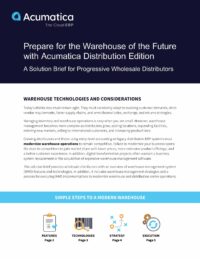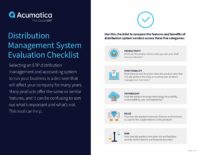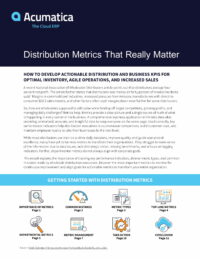Enterprise Resource Planning: The Cornerstone of Warehouse Automation
The almost futuristic technologies listed above are incredible advancements for the warehousing and distribution industries, but they can’t reach their full potential in the absence of foundational (and equally advanced) business management software. A cobot can complete tasks and a drone can locate inventory—but they can’t do it on their own. They need a “brain” of data to feed and guide them.
That’s where warehouse automation powered by enterprise resourcing planning (ERP) software comes in.
An ERP system acts as a centralized repository for all of a business’s data—from customer and inventory information to carrier and supply chain logistics and beyond. It captures, analyzes, and reports on this data automatically, placing all the information necessary for data-driven decisions at employees’ fingertips.
It can integrate with critical third-party software to make warehouse automation more efficient—such as linking to digital scales and printers to automatically weigh shipments and print appropriate shipping labels and packing slips. An ERP system with a strong warehouse management component can also:
- Facilitate paperless, directed picking from mobile devices or scanners.
- Automatically generate wave and batch pick lists based on the best path for every picker.
- Calculate correct package sizes to ensure safe, environmentally sustainable transport.
- Generate shipping labels and packing slips that comply with industry regulations.
- Streamline stock movement and provide a clear picture of inventory turnover rates.
Such an ERP system is the true cornerstone of warehouse automation and a lasting investment for success now and in the future.
Advantages of Warehouse Automation
Though businesses may have qualms about the time and expense of investing in and implementing warehouse automation technologies, the benefits of doing so far outweigh those concerns.

Here are four of the main benefits businesses can expect:
Improved Efficiency and Productivity
Equipping workers with warehouse automation technologies helps them complete their tasks faster and more easily. These technologies also alleviate the boredom that comes with performing recurring tasks (e.g., sorting items, switching between disconnected systems for data, etc.) and ensure that workers can fill orders efficiently and accurately.
Workers also don’t have to traverse the entire warehouse to find items. They can save time (and their feet) by using light, voice, or drone-powered features to direct them to inventory locations—or they can just stay in one place and let the technology deliver what they need, when they need it. They can also use an advanced ERP system to automatically collect data from the warehouse or shop floor—no need to manually sift through reams of data or make unnecessary, time-wasting trips to physically find stock.
Savings and Space Optimization
When comparing the operational costs of an inefficient warehouse (e.g., poor inventory management, inaccurate labor forecasting, and manual- and paper-based processes) to the cost of investing in warehouse automation technologies, businesses will find that numbers don’t lie. Warehouse automation enhances accuracy, speeds up operations, and reduces losses, which adds up to monetary savings and improved customer satisfaction.
As to space optimization, warehouse automation technologies allow businesses to take advantage of every square foot of warehouse space they possess. Through configurable role-based dashboards, an ERP system helps employees see what stock is available, where it is located, how many units of the items are available, and how in demand each item is. And, while space optimization may hamper employees, who have to work around higher selves and narrower aisles, navigating tight spaces is no problem for cobots, drones, or other warehouse automation technologies.
Enhanced Safety and Sustainability
With warehouse automation technologies, businesses enhance their employees’ safety by eliminating the need for them to handle potentially toxic products, to use pallet jacks or forklifts to reach top-rack items, and to lift/push/pull heavy or bulky products. The warehouse automation features available in an ERP system help in this endeavor by keeping everyone up to date and on the same page.
If employees can easily communicate with one another and work based on the same information, there are fewer opportunities for missteps or costly accidents. As human error is eliminated, overall accuracy improves, and environmental sustainability is enhanced by the resultant increased efficiency, decreased operating costs, and reduced waste.
Increased Flexibility
Finally, warehouse automation helps businesses become more agile and adapt to demand fluctuations. A modern ERP solution can scale up or down a business as it changes over time, and other automation technologies (like robots) can help businesses navigate labor shortages and work effectively with a smaller staff.





